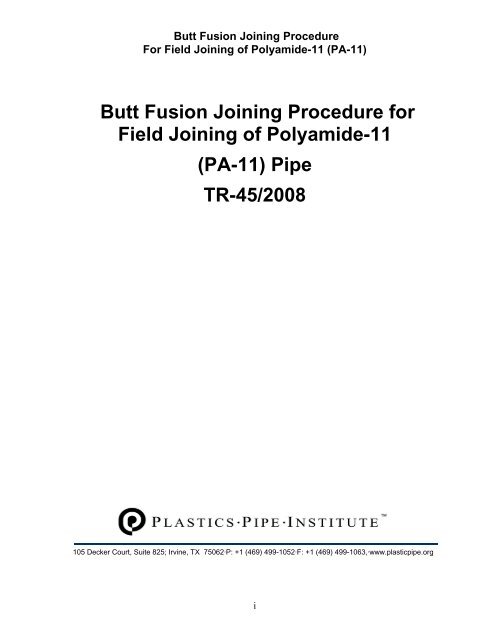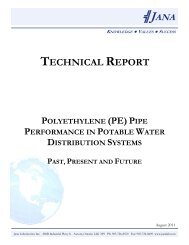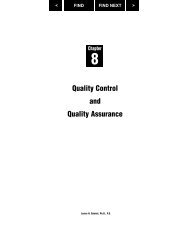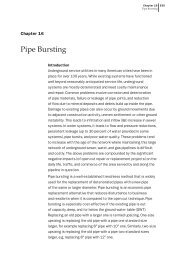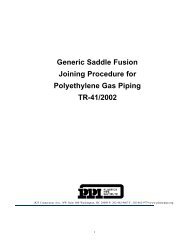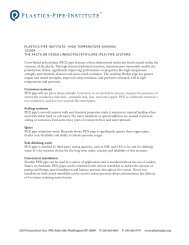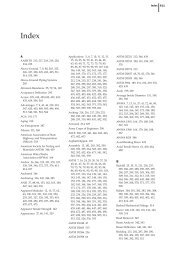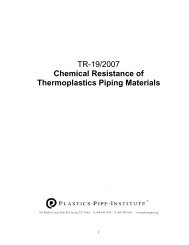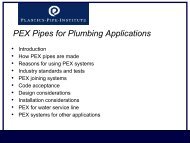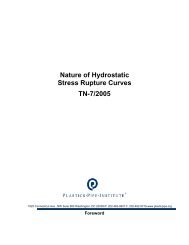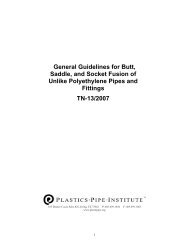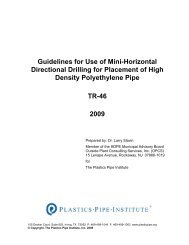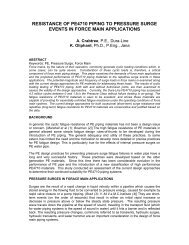Butt Fusion Joining Procedure for Field Joining of Polyamide-11
Butt Fusion Joining Procedure for Field Joining of Polyamide-11
Butt Fusion Joining Procedure for Field Joining of Polyamide-11
You also want an ePaper? Increase the reach of your titles
YUMPU automatically turns print PDFs into web optimized ePapers that Google loves.
<strong>Butt</strong> <strong>Fusion</strong> <strong>Joining</strong> <strong>Procedure</strong>For <strong>Field</strong> <strong>Joining</strong> <strong>of</strong> <strong>Polyamide</strong>-<strong>11</strong> (PA-<strong>11</strong>)Table <strong>of</strong> ContentsFOREWORDiiiINTRODUCTION 4SCOPE 4TESTING PROGRAM 5INTRODUCTION 5FUSION PARAMETERS 5TESTING PARAMETERS 6CONCLUSIONS AND RECOMMENDATIONS 6Other Acceptable <strong>Fusion</strong> <strong>Procedure</strong>s 7APPENDIX A – <strong>Butt</strong> <strong>Fusion</strong> <strong>Joining</strong> <strong>Procedure</strong> <strong>for</strong> <strong>Field</strong> <strong>Joining</strong> PA-<strong>11</strong>(<strong>Polyamide</strong>-<strong>11</strong>) Pipe 8<strong>Butt</strong> <strong>Fusion</strong> Parameters: 8<strong>Butt</strong> <strong>Fusion</strong> <strong>Procedure</strong>: 8Secure 8Face 9Align 9Melt 9Table 1 Approximate Melt Bead Size 10<strong>Joining</strong> 10Hold 10Visual Inspection 10APPENDIX B – LETTERS OF COMPLIANCE FROM PPI MEMBER COMPANIESFOR 49 CFR §192.283 FOR PIPE INTENDED FOR GAS DISTRIBUTIONAPPLICATIONS 16APPENDIX C – ILLUSTRATION OF A PROPERLY MADE PA-<strong>11</strong> BUTT FUSIONJOINT 17ii
<strong>Butt</strong> <strong>Fusion</strong> <strong>Joining</strong> <strong>Procedure</strong>For <strong>Field</strong> <strong>Joining</strong> <strong>of</strong> <strong>Polyamide</strong>-<strong>11</strong> (PA-<strong>11</strong>)FOREWORDThis report was developed and published with the technical help <strong>of</strong> the members <strong>of</strong>the PPI (Plastics Pipe Institute, Inc.). The members have shown their interest inquality products by assisting independent standards-making and user organizationsin the development <strong>of</strong> standards, and also by developing reports on an industry-widebasis to help engineers, code <strong>of</strong>ficials, specifying groups, and users.The purpose <strong>of</strong> this technical report is to provide important in<strong>for</strong>mation available toPPI on a particular aspect <strong>of</strong> polyethylene pipe butt fusion to engineers, users,contractors, code <strong>of</strong>ficials, and other interested parties. More detailed in<strong>for</strong>mationon its purpose and use is provided in the document itself.This report has been prepared by PPI as a service <strong>of</strong> the industry. The in<strong>for</strong>mationin this report is <strong>of</strong>fered in good faith and believed to be accurate at the time <strong>of</strong> itspreparation, but is <strong>of</strong>fered without any warranty, expressed or implied, includingWARRANTIES OF MERCHANTABILITY AND FITNESS FOR A PARTICULARPURPOSE. Consult the manufacturer <strong>for</strong> more detailed in<strong>for</strong>mation about theparticular joining procedures to be used with its piping products. Any reference to ortesting <strong>of</strong> a particular proprietary product should not be construed as anendorsement by PPI, which does not endorse the proprietary products or processes<strong>of</strong> any manufacturer. The in<strong>for</strong>mation in this report is <strong>of</strong>fered <strong>for</strong> consideration byindustry members in fulfilling their own compliance responsibilities. PPI assumes noresponsibility <strong>for</strong> compliance with applicable laws and regulations.PPI intends to revise this report from time to time, in response to comments andsuggestions from users <strong>of</strong> the report. Please send suggestions <strong>of</strong> improvements tothe address below. In<strong>for</strong>mation on other publications can be obtained by contactingPPI directly or visiting the web site.The Plastics Pipe Institute, Inc.http://www.plasticpipe.orgJanuary 2008iii
INTRODUCTION<strong>Butt</strong> <strong>Fusion</strong> <strong>Joining</strong> <strong>Procedure</strong>For <strong>Field</strong> <strong>Joining</strong> <strong>of</strong> <strong>Polyamide</strong>-<strong>11</strong> (PA-<strong>11</strong>)In 1994, representatives <strong>of</strong> the U.S. DOT (Department <strong>of</strong> Transportation), Office <strong>of</strong>Pipeline Safety requested that the Plastics Pipe Institute (PPI) assist in promotinggreater uni<strong>for</strong>mity in the joining procedures utilized by gas utilities in the butt fusion <strong>of</strong>polyethylene (PE) gas piping products. DOT reported that it had encountered aproliferation <strong>of</strong> similar but slightly varying joining procedures from individual PE pipeproducers. The slight differences in the various procedures made it more difficult <strong>for</strong>pipeline operators to qualify persons with appropriate training and experience in the use<strong>of</strong> these procedures. It was even more difficult <strong>for</strong> DOT to en<strong>for</strong>ce the joiningrequirements in § 192.283 (Plastic pipe, qualifying joining procedures) <strong>of</strong> the C.F.R.(Code <strong>of</strong> Federal Regulations) Title 49.In response to DOT’s request, PPI established a task group to develop a generic buttfusion procedure <strong>for</strong> the fusion joining <strong>of</strong> polyethylene piping in the <strong>for</strong>m <strong>of</strong> the publishedPPI TR-33.In the spirit <strong>of</strong> complying with the above request a second task group was <strong>for</strong>med todevelop a butt fusion procedure <strong>for</strong> the joining <strong>of</strong> polyamide-<strong>11</strong> (PA-<strong>11</strong>) piping. PA-<strong>11</strong>piping is approved <strong>for</strong> use in piping systems under the jurisdiction <strong>of</strong> CFR Title 49 Part192 by reference <strong>of</strong> ASTM D 2513 in 192.7. PA-<strong>11</strong> gas piping requirements aredetailed in Annex A5 <strong>of</strong> ASTM D 2513. Thus this PPI technical report provides auni<strong>for</strong>m joining procedure bringing greater consistency to this aspect <strong>of</strong> gas pipelineinstallation, facilitate the pipeline operator’s ef<strong>for</strong>ts to qualify the procedure, reducecosts, and simplify DOT’s en<strong>for</strong>cement duties.SCOPEThe program undertaken by the PPI Task Group <strong>for</strong> the testing <strong>of</strong> representativematerials under a set <strong>of</strong> conditions was designed to reflect the fusion conditionsrecommended <strong>for</strong> the butt fusion <strong>of</strong> PA-<strong>11</strong> piping. <strong>Butt</strong> fusion evaluation work wasper<strong>for</strong>med starting in the mid 1990s by the Gas Research Institute 1 and continued atMcElroy Manufacturing, Inc. and in the Arkema (<strong>for</strong>merly At<strong>of</strong>ina) R&D laboratories inPennsylvania. The results <strong>of</strong> these studies, as detailed below, resulted in therecommended fusion procedures contained in Appendix A <strong>of</strong> this report. It is theintention that this procedure would be available <strong>for</strong> use by pipeline operators who woulddetermine whether the procedure is appropriate <strong>for</strong> use with the PA-<strong>11</strong> piping productsit employs. Pipeline operators could consider the recommendations and testingper<strong>for</strong>med by others in their ef<strong>for</strong>t to comply with the fusion procedure qualificationrequirements <strong>of</strong> 49 C.F.R. § 192.283 (Plastic pipe, qualifying joining procedures).It is important to emphasize that the testing per<strong>for</strong>med was intended only to establish atechnical basis <strong>for</strong> developing and proposing a more generic fusion joining procedurethat would <strong>of</strong>fer the maximum opportunity to be qualified and used by pipeline1 H.V. Patadia, R.H. Doctor, “Final Report – Part I: Technical Reference on the Physical, Mechanical,and Chemical Properties <strong>of</strong> PA<strong>11</strong> Pipe Materials <strong>for</strong> Use in Gas Distribution Systems Operating at HigherPressures and Temperatures,” GRI-99/0039, 55 (1998).4
<strong>Butt</strong> <strong>Fusion</strong> <strong>Joining</strong> <strong>Procedure</strong>For <strong>Field</strong> <strong>Joining</strong> <strong>of</strong> <strong>Polyamide</strong>-<strong>11</strong> (PA-<strong>11</strong>)operators. The testing was not intended to qualify the procedure <strong>for</strong> use with any PA-<strong>11</strong>piping manufacturer’s particular pipe product, and PPI <strong>of</strong>fers no opinion on whether theprocedure is properly qualified <strong>for</strong> use with any particular PA-<strong>11</strong> piping. PA-<strong>11</strong> pipeproducers remain solely responsible <strong>for</strong> any representations that they may make aboutthe use <strong>of</strong> this procedure or any other joining procedure with their proprietary PA-<strong>11</strong>piping products, and pipeline operators remain solely responsible <strong>for</strong> compliance withthe requirements <strong>of</strong> 49 C.F.R. § 192.283 (Plastic pipe, qualifying joining procedures)when qualifying any procedure <strong>for</strong> use with the products it selects <strong>for</strong> its pipelines. PPImember pipe manufacturers have endorsed this procedure <strong>for</strong> joining their product toitself and to other commercially available PA-<strong>11</strong> pipe materials. Pipe producercompliance letters are in Appendix B <strong>for</strong> gas pipe applications. A typical illustration <strong>of</strong> aproperly made PA-<strong>11</strong> butt fusion joint is shown in Appendix C.PPI hopes that the inherent value <strong>of</strong> greater uni<strong>for</strong>mity will provide all the incentivenecessary <strong>for</strong> companies to evaluate the procedure in Appendix A as a first option <strong>for</strong>butt fusion joining <strong>of</strong> its PA-<strong>11</strong> piping products. Use <strong>of</strong> this procedure is obviously notmandatory, and every PA-<strong>11</strong> pipe producer and pipeline operator retains the option <strong>of</strong>developing different procedures <strong>for</strong> its particular products and pipelines. However, PPIbelieves that its work in developing this procedure as a candidate <strong>for</strong> widespreadacceptance throughout the industry will lead to greater efficiency, simplicity, andunderstanding in this area and promote the use <strong>of</strong> effective, qualified procedures <strong>for</strong>butt fusion joining <strong>of</strong> PA-<strong>11</strong> pipe.TESTING PROGRAM 2INTRODUCTIONIn order to validate an appropriate butt fusion procedure <strong>for</strong> polyamide <strong>11</strong> (PA-<strong>11</strong>) pipe,an in-depth fusion study was undertaken, with the underlying goal <strong>of</strong> establishing theoptimum conditions <strong>for</strong> making a good fusion. An added objective <strong>of</strong> this study was toestablish visual standards depicting the wide variety <strong>of</strong> bead appearancescorresponding to a good fusion. The details <strong>of</strong> this testing program and the test dataare contained in the below footnoted report by Dr. John Chen.FUSION PARAMETERSThis study is supplemental to a previous testing program conducted by McElroyManufacturing and the Gas Research Institute (now the Gas Technology Institute, or2 Dr. John Chen; Optimization <strong>of</strong> Parameters Influencing <strong>Butt</strong> <strong>Fusion</strong> Integrity in <strong>Polyamide</strong> <strong>11</strong> Pipe;Presented at Natural Gas Technologies 2005: What’s New & What’s Next (2005)5
<strong>Butt</strong> <strong>Fusion</strong> <strong>Joining</strong> <strong>Procedure</strong>For <strong>Field</strong> <strong>Joining</strong> <strong>of</strong> <strong>Polyamide</strong>-<strong>11</strong> (PA-<strong>11</strong>)GTI) using McElroy’s high-speed tensile impact test 3 . Based on this previous study, theoptimum butt fusion parameters <strong>for</strong> 2” SDR<strong>11</strong> PA-<strong>11</strong> pipe were determined to be:Heater surface temperature:Interfacial pressure:495 – 505 o F60 – 90 psiHeating (soak) time:60 – 75 seconds.The current study outlined in this report serves to independently revalidate and updatethe findings <strong>of</strong> the previous study using ASTM D 1599 Quick Burst and ASTM D 638Tensile Testing, both required by the D.O.T. Code <strong>of</strong> Federal Regulations (CFR)192.283 <strong>for</strong> qualifying joining procedures <strong>for</strong> plastic pipe. The end goal is to find if anyor all <strong>of</strong> the parameter values used in this study qualify <strong>for</strong> use in the joining procedure,and if so, determine the optimum values <strong>for</strong> producing fusions with the best possibleproperties.TESTING PARAMETERSTesting per<strong>for</strong>med in this study included:• Quick Burst testing <strong>of</strong> joints in accordance with ASTM D 1599 (192.283);• Tensile Testing <strong>of</strong> joints in accordance with ASTM D 638 at 0.2 ipm (192.283);• Sustained Pressure Testing in accordance with ASTM D 1598o 80°C, 1850 psi hoop stress (14% above the hoop stress requirement inASTM F 1733 Standard Specification <strong>for</strong> <strong>Butt</strong> Heat <strong>Fusion</strong> <strong>Polyamide</strong> (PA)Fitting <strong>for</strong> <strong>Polyamide</strong> (PA) Plastic Pipe and Tubing) All ductile pipe failuresoutside <strong>of</strong> fusion joint (or non failures).CONCLUSIONS AND RECOMMENDATIONSThe results <strong>of</strong> this study indicate that there is a single fusion procedure with definedranges <strong>of</strong> acceptable heater surface temperature, 495-505°F, and interfacial pressure,60-90 psi (4.14-6.21 bar), <strong>for</strong> fusing PA-<strong>11</strong> piping. The results further indicate that thereis a strong likelihood that the fusion procedure used in this testing (see Appendix A)could be qualified by gas pipeline operators under DOT’s regulations in Part 192 <strong>for</strong> usewith most <strong>of</strong> these PA-<strong>11</strong> gas piping products. To the extent that this PPI procedure in3 T. Striplin, memo “<strong>Butt</strong> <strong>Fusion</strong> Parameters,” McElroy Manufacturing, Inc., (1995).6
<strong>Butt</strong> <strong>Fusion</strong> <strong>Joining</strong> <strong>Procedure</strong>For <strong>Field</strong> <strong>Joining</strong> <strong>of</strong> <strong>Polyamide</strong>-<strong>11</strong> (PA-<strong>11</strong>)Appendix A can be qualified <strong>for</strong> use with PA-<strong>11</strong> piping, the closer the industry can moveto meeting DOT’s objective <strong>of</strong> greater uni<strong>for</strong>mity, efficiency, and simplicity in the area <strong>of</strong>fusion procedures.Other Acceptable <strong>Fusion</strong> <strong>Procedure</strong>sIt must be recognized that there are many other different procedures and fusionparameters used throughout the world that have been proven to make effective, reliablejoints. The pipeline operator and every pipe producer retain the option <strong>of</strong> developingdifferent fusion procedures <strong>for</strong> its particular products and pipelines. In certain cases,due to operating conditions, weather, or the characteristics <strong>of</strong> the joining equipment, itmay be necessary or even advisable to use another procedure.PPI believes that its work in developing this procedure as a candidate <strong>for</strong> widespreadacceptance throughout the industry will lead to greater efficiency, simplicity andunderstanding in this area and promote the use <strong>of</strong> effective, qualified procedures <strong>for</strong>butt fusion joining <strong>of</strong> PA-<strong>11</strong> piping.7
<strong>Butt</strong> <strong>Fusion</strong> <strong>Joining</strong> <strong>Procedure</strong>For <strong>Field</strong> <strong>Joining</strong> <strong>of</strong> <strong>Polyamide</strong>-<strong>11</strong> (PA-<strong>11</strong>)APPENDIX A – <strong>Butt</strong> <strong>Fusion</strong> <strong>Joining</strong> <strong>Procedure</strong> <strong>for</strong> <strong>Field</strong> <strong>Joining</strong> PA-<strong>11</strong>(<strong>Polyamide</strong>-<strong>11</strong>) PipeThis procedure has not been qualified <strong>for</strong> use with any particular piping product orcombination <strong>of</strong> piping products and must be qualified <strong>for</strong> use in accordance with 49 CFRPart 192 prior to its use to join PA-<strong>11</strong> pipe in a gas pipeline. Any copying orreproduction <strong>of</strong> this procedure without this paragraph and the accompanying TR-XX is aviolation <strong>of</strong> the copyright.This procedure is intended <strong>for</strong> butt fusion joining <strong>of</strong> PA-<strong>11</strong> fuel gas pipe produced inaccordance with ASTM D 2513.<strong>Butt</strong> <strong>Fusion</strong> Parameters:<strong>Fusion</strong> Interface Pressure Range 4 60-90 psiHeater Surface Temperature Range 495 - 505°F<strong>Butt</strong> <strong>Fusion</strong> <strong>Procedure</strong>:The principle <strong>of</strong> heat fusion is to heat two surfaces to a designated temperature,then fuse them together by application <strong>of</strong> a sufficient <strong>for</strong>ce. This <strong>for</strong>ce causes themelted materials to flow and mix, thereby resulting in fusion. When fusedaccording to the proper procedures, the joint area becomes as strong as orstronger than the pipe itself in both tensile and pressure properties.<strong>Field</strong>-site butt fusions may be made readily by trained operators using butt fusionmachines that secure and precisely align the pipe ends <strong>for</strong> the fusion process.The six steps involved in making a butt fusion joint are:1. Securely fasten the components to be joined2. Face the pipe ends3. Align the pipe pr<strong>of</strong>ile4. Melt the pipe interfaces5. Join the two pr<strong>of</strong>iles together6. Hold under pressureSecureClean the inside and outside <strong>of</strong> the pipe to be joined by wiping with a clean lintfreecloth. Remove all <strong>for</strong>eign matter.Clamp the components in the machine. Check alignment <strong>of</strong> the ends and adjustas needed.4 Interfacial pressure is used to determine fusion joining pressure settings <strong>for</strong> hydraulic butt fusionmachines when joining specific pipe diameters and DR’s. Interfacial pressure is NOT the gauge pressure.8
<strong>Butt</strong> <strong>Fusion</strong> <strong>Joining</strong> <strong>Procedure</strong>For <strong>Field</strong> <strong>Joining</strong> <strong>of</strong> <strong>Polyamide</strong>-<strong>11</strong> (PA-<strong>11</strong>)FaceAlignMeltThe pipe ends must be faced to establish clean, parallel mating surfaces. Most, ifnot all, equipment manufacturers have incorporated the rotating planer blockdesign in their facers to accomplish this goal. Facing is continued until a minimaldistance exists between the fixed and movable jaws <strong>of</strong> the machine and the faceris locked firmly and squarely between the jaw bushings. Open the jaws andremove the facer. Remove any pipe chips from the facing operation and any<strong>for</strong>eign matter with a clean, lint-free cotton cloth. Bring the pipe ends togetherwith minimal <strong>for</strong>ce and inspect the face <strong>of</strong>f. A visual inspection <strong>of</strong> this operationshould verify square faces, perpendicular to the pipe centerline on each pipe endand with no detectable gap.The pipe pr<strong>of</strong>iles must be rounded and aligned with each other to minimizemismatch (high-low) <strong>of</strong> the pipe walls. This can be accomplished by tighteningclamping jaws until the outside diameters <strong>of</strong> the pipe ends match. The jaws mustnot be loosened or the pipe may slip during fusion. Re-face the pipe ends andremove any chips from re-facing operation with a clean, lint-free cotton cloth.Heating tools that simultaneously heat both pipe ends are used to accomplishthis operation. These heating tools are normally furnished with thermometers tomeasure internal heater temperature so the operator can monitor thetemperature be<strong>for</strong>e each joint is made. However, the thermometer can be usedonly as a general indicator because there is some heat loss from internal toexternal surfaces, depending on factors such as ambient temperatures and windconditions. A pyrometer or other surface temperature-measuring device shouldbe used be<strong>for</strong>e the first joint <strong>of</strong> the day and periodically throughout the day toinsure proper temperature <strong>of</strong> the heating tool face that contacts the pipe or fittingends. Additionally, heating tools are usually equipped with suspension andalignment guides that center them on the pipe ends. The heater faces that comeinto contact with the pipe should be clean, oil-free and coated with a permanentnonstick coating as recommended by the manufacturer to prevent molten plasticfrom sticking to the heater surfaces. Remaining molten plastic can interfere withfusion quality and must be removed according to the tool manufacturer’sinstructions. Never use chemical cleaners or solvents to clean heating toolsurfaces.The surface temperatures must be in the temperature range 495-505°F. Installthe heater in the butt fusion machine and bring the pipe ends into full contact withthe heater. To ensure that full and proper contact is made between the pipeends and the heater, the initial contact should be under moderate pressure. Afterholding the pressure very briefly, it should be released without breaking contact.On larger pipe sizes, initial pressure may be maintained until a slight melt isobserved around the circumference <strong>of</strong> the pipe be<strong>for</strong>e releasing pressure.Continue to hold the components in contact with each other, without <strong>for</strong>ce, whilea bead <strong>of</strong> molten polyamide-<strong>11</strong> develops between the heater and the pipe ends.9
<strong>Butt</strong> <strong>Fusion</strong> <strong>Joining</strong> <strong>Procedure</strong>For <strong>Field</strong> <strong>Joining</strong> <strong>of</strong> <strong>Polyamide</strong>-<strong>11</strong> (PA-<strong>11</strong>)When the proper bead size is <strong>for</strong>med against the heater surfaces all around thepipe or fitting ends, remove the heater. Melt bead size is dependent on pipe size.See Table 1 <strong>for</strong> approximate bead sizes.Table 1 Approximate Melt Bead SizePipe SizeApproximate Melt Bead Size1 ¼” and smaller (40mm and smaller) 1/32” – 1/16” (1-2mm)Above 1 ¼” through 3” (above 40mm-90mm) About 1/16” (2mm)Above 3” through 8” (above 90mm-225mm) 1/8”-3/16” (3-5mm)Above 8” through 12” (above 225mm-315mm) 3/16”-1/4” (5-6mm)<strong>Joining</strong>After the heater tool is removed, quickly inspect the pipe ends (NOTE: If aconcave melt surface is observed, unacceptable pressure during heating hasoccurred and the joint will be low quality. Do not continue. Allow the componentends to cool completely, and restart at the beginning. Except <strong>for</strong> a very brief timeto seat the components fully against the heater tool, do not apply pressure duringheating.), then immediately bring the molten pipe ends together with sufficientfusion <strong>for</strong>ce to <strong>for</strong>m a bead against the pipe wall.For larger manual and hydraulic butt fusion machines, fusion <strong>for</strong>ce is determinedby multiplying the interfacial pressure, 60-90 psi, by the pipe area. For manuallyoperated fusion machines, a torque wrench may be used to apply the proper<strong>for</strong>ce. For hydraulically operated fusion machines, the fusion <strong>for</strong>ce can bedivided by the total effective piston area <strong>of</strong> the carriage cylinders to give ahydraulic gauge reading in psi. The gauge reading is theoretical; internal andexternal drags are added to this figure to obtain the actual fusion pressurerequired by the machine. The hydraulic gauge reading is dependent upon pipediameter, DR and machine design. Interfacial pressure and gauge reading arenot the same value.HoldHold the molten joint immobile under fusion <strong>for</strong>ce until the joint has cooledadequately to develop strength. Allowing proper cooling time under fusion <strong>for</strong>ceprior to removal from the clamps <strong>of</strong> the machine is important in achieving jointintegrity. The fusion <strong>for</strong>ce should be held between the pipe ends until the surface<strong>of</strong> the melt bead is cool to the touch.Avoid pulling, installation or rough handling <strong>for</strong> an additional 30 minutes.Visual InspectionVisually inspect and compare the joint against the manufacturer’s recommendedappearance guidelines. Visually, the width <strong>of</strong> butt fusion beads should be10
<strong>Butt</strong> <strong>Fusion</strong> <strong>Joining</strong> <strong>Procedure</strong>For <strong>Field</strong> <strong>Joining</strong> <strong>of</strong> <strong>Polyamide</strong>-<strong>11</strong> (PA-<strong>11</strong>)approximately 1-1 ½ times the bead height above the pipe and the fusion beadshould be rounded and uni<strong>for</strong>mly sized all around the pipe circumference (seeAppendix C). Note in fusing PA-<strong>11</strong> piping a single roll back bead is <strong>for</strong>medas opposed to the double roll back bead observed when fusing PE(polyethylene) piping. Examples <strong>of</strong> acceptable fusions made to this procedureare shown in figures A3 and A4. The presence <strong>of</strong> bubbles in the fusion bead isnormal and can vary <strong>for</strong> PA-<strong>11</strong>, which absorbs up to about 2% by weight waterupon storage. Higher moisture content pipe and fittings will exhibit more bubblesin the fusion bead. The bubbles do not adversely affect the fusion strength, andare present only in the bead, not in the fused pipe wall. When butt fusing tomolded fittings, the fitting-side bead may display shape irregularities such asminor indentations, deflections and non-uni<strong>for</strong>m bead rollover from molded partcooling and knit lines. In such cases, visual evaluation is based mainly on thesize and shape <strong>of</strong> the pipe-side bead. Visually unacceptable joints should be cutout and re-fused using the correct procedure. (See manufacturer’s visualinspection guidelines)Coiled pipe is available in sizes through 4” IPS. Coiling may leave a set in somepipe sizes that must be addressed in the preparation <strong>of</strong> the butt fusion process.There are several ways to address this situation:1. Straighten and re-round coiled pipe be<strong>for</strong>e the butt fusion process. (ASTM D2513 requires field re-rounding <strong>of</strong> coiled pipe be<strong>for</strong>e joining pipe sizes largerthan 3” IPS.)2. If there is still curvature present, install the pipe ends in the fusion machine inan “S” configuration with print lines approximately 180° apart in order to helpgain proper alignment and help produce a straight joint. See Figure A1Every ef<strong>for</strong>t should be made to make the joint perpendicular to the axis <strong>of</strong> thepipe.<strong>11</strong>
<strong>Butt</strong> <strong>Fusion</strong> <strong>Joining</strong> <strong>Procedure</strong>For <strong>Field</strong> <strong>Joining</strong> <strong>of</strong> <strong>Polyamide</strong>-<strong>11</strong> (PA-<strong>11</strong>)Figure A1 Alignment <strong>of</strong> Coiled Pipe Ends Through a <strong>Butt</strong> <strong>Fusion</strong> Machine12
<strong>Butt</strong> <strong>Fusion</strong> <strong>Joining</strong> <strong>Procedure</strong>For <strong>Field</strong> <strong>Joining</strong> <strong>of</strong> <strong>Polyamide</strong>-<strong>11</strong> (PA-<strong>11</strong>)3. Visually mitered (angled, <strong>of</strong>f-set) joints should be cut out and re-fused.Figure A2 Visually unacceptable mitered joint13
<strong>Butt</strong> <strong>Fusion</strong> <strong>Joining</strong> <strong>Procedure</strong>For <strong>Field</strong> <strong>Joining</strong> <strong>of</strong> <strong>Polyamide</strong>-<strong>11</strong> (PA-<strong>11</strong>)Figure A3 Examples <strong>of</strong> Acceptable PA-<strong>11</strong> <strong>Fusion</strong>s14
<strong>Butt</strong> <strong>Fusion</strong> <strong>Joining</strong> <strong>Procedure</strong>For <strong>Field</strong> <strong>Joining</strong> <strong>of</strong> <strong>Polyamide</strong>-<strong>11</strong> (PA-<strong>11</strong>)Fig. A4 Sectioned Acceptable PA-<strong>11</strong> <strong>Fusion</strong>s15
<strong>Butt</strong> <strong>Fusion</strong> <strong>Joining</strong> <strong>Procedure</strong>For <strong>Field</strong> <strong>Joining</strong> <strong>of</strong> <strong>Polyamide</strong>-<strong>11</strong> (PA-<strong>11</strong>)APPENDIX B – LETTERS OF COMPLIANCE FROM PPI MEMBERCOMPANIES FOR 49 CFR §192.283 FOR PIPE INTENDED FOR GASDISTRIBUTION APPLICATIONSNOTE: Until a Final Rule is issued on two PA-<strong>11</strong> petitions <strong>for</strong> proposed rulemaking is adopted byPHMSA, PA-<strong>11</strong> is being installed only under waiver at pressures greater than 100 psig and with adesign factor <strong>of</strong> 0.40. Until the final rulemaking, there are no letters <strong>of</strong> compliance from PPImember companies as this fusion procedure is used <strong>for</strong> these waiver installations.16
<strong>Butt</strong> <strong>Fusion</strong> <strong>Joining</strong> <strong>Procedure</strong>For <strong>Field</strong> <strong>Joining</strong> <strong>of</strong> <strong>Polyamide</strong>-<strong>11</strong> (PA-<strong>11</strong>)APPENDIX C – ILLUSTRATION OF A PROPERLY MADE PA-<strong>11</strong> BUTTFUSION JOINTNote: The presence <strong>of</strong> bubbles in the bead is normal, and varies with the amount <strong>of</strong> absorbed water inthe pipe and/or fitting. When butt fusing to molded fittings, the fitting side bead may have an irregularappearance.17


